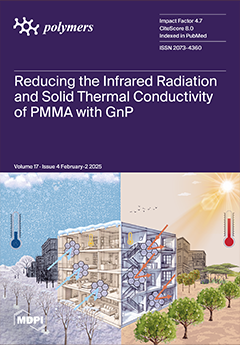The rigid V-shaped Tröger’s base (
TB) unit has been proven efficacious in creating microporosity, making
TB-based polyimides (PIs) exhibiting significant advantages in simultaneously increasing gas permeability and selectivity for the separation industry. However,
TB-based PIs commonly display undesired mechanical
[...] Read more.
The rigid V-shaped Tröger’s base (
TB) unit has been proven efficacious in creating microporosity, making
TB-based polyimides (PIs) exhibiting significant advantages in simultaneously increasing gas permeability and selectivity for the separation industry. However,
TB-based PIs commonly display undesired mechanical performance due to the low molecular weight resulting from the evident steric hindrance and low reactivity of
TB-containing diamines. Herein, a novel diamine-containing bisimide linkage (
BIDA) has been synthesized and then polymerized with paraformaldehyde via a moderate “
TB polymerization” strategy to furnish polymers simultaneously, including imide linkages and
TB units in the polymer main chains, namely,
TB-PIs. This
TB polymerization strategy avoids the direct polymerization of dianhydride with low-reactivity
TB diamine. After incorporating a meta-methyl substituent into
BIDA diamine, the
m-
MBIDA diamine-derived
m-
MTBPI ultimately exhibits a high molecular weight, good tensile strength (90.4 MPa) and an outstanding fracture toughness (45.1 MJ/m
3). And more importantly, the
m-
MTBPI membrane displays an evidently enhanced gas separation ability in comparison with
BIDA-derived
TBPI, with overall separation properties much closer to the 1991 Robeson upper bound. Moreover, no sign of plasticization appears for the
m-
MTBPI membrane when separating a high-pressure CO
2/CH
4 mixture (
v/
v = 1/1) up to 20 bar, with the CO
2/CH
4 mixed-gas separation performance approaching the 2018 upper bound.
Full article






